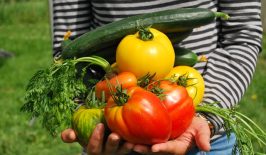With World Kitchen Garden Day taking place this weekend, we take a look at some of the ways technology is helping kitchen gardeners worldwide cultivate a better homegrown crop.
Much has been said of late about the rewards urban agriculture can reap. What can start out as hobby has the potential to yield substantial benefits for the environment, food security and, on a personal level, the weekly household shopping bill. Lately, there has been an advent of technological tools designed to facilitate setting up and managing your own kitchen garden. From smartphone apps that plot gardens to infrared cameras measuring plant photosynthesis, there is a host of tech support on the market to suit gardening novices and pros alike.
Apps for Apples…and a Whole Lot More
There is a variety of mobile apps on offer to help plot gardens, calculate the number of plants suitable for an lot and advise long-term planning and care strategies for your kitchen garden. Garden Plan Pro (from GrowVeg.com and available for desktop, iPhone and iPad) relies on an extensive database of plants and records from more than 6,500 weather stations worldwide to help you plot a garden of any size and shape. The app gets you started by calculating how many plants can fit in the amount of space you have, advise on suitable crop rotation and help with long-term planning and and care for your garden.
Steady, Aim, Shoot
Cameras are also becoming a trusty gardening tool. Seen a striking flower that you’d like to add to your own home foliage but unsure of what it is? The Google Search app has a feature called Google Goggles which allows users to (among other things) snap pictures of flowers, plants and veggies on a camera phone and the app will search Google’s image database to identify the plant species.
Infragram is a new project that provides people with the tools for assessing a key element of plant health. Created by the team at Public Lab, the Infragram project comprises special-made, low-cost cameras and lenses that allow users to capture infrared imagery to help measure the rate at which plants are converting light into oxygen, a tried and true method of examining plant health long used by farmers and NASA. The project is still in the development phase, with the Massachussetts-based team just completing a very successful Kickstarter campaign (though it is unclear whether Infragram products will become available outside the USA).

Keeping It Simple…and Soil-less
Growing plants without soil beggars belief, if you go by conventional gardening wisdom. Yet a group of crafty gardeners at Pepperagro in Bangalore looked to provide urban agriculture solutions to city-dwellers while simultaneously keeping the population’s need for fertile soil in check. Their idea? An organic, eco-friendly planting box that comes ready to install with potting bag, organic potting mix and organic additive and just requires seeds and water.
Find out more about World Kitchen Garden Day by visiting the websites of international body Kitchen Gardeners International and Urban Leaves in Mumbai and check out our step-by-step guide to setting up your own kitchen garden.
Author: Anna Rees/ RESET editorial


